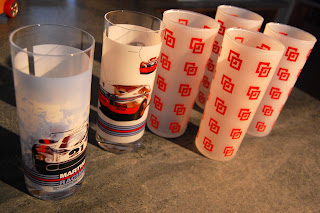




Now that the racing season is over, I decided to make some of the larger changes that I refrained from during the season. I wanted to complete the races this year with basically the same set-up so I could work on my driving and get used to the tracks, not different set-ups.
The work today, it was sunny but brisk in Denver this late November Saturday, was to lower the rear of the car. I went out thinking it would be a one hour job. It took three and a half. Why? Me make stupid mistake sometimes.
So, I jack the car up, unhook the shocks and get ready to easily remove the torsion bars. Or so I thought. I had drilled holes in the rockers and affixed tabs to the torsion bars to specifically make this job easier.
But no matter what I did, I could not get the torsion bars to budge. And since they were new and well-greased I knew they should easily slide out when the splines, pressure and planets aligned. But no go.
I used the standard approach of a jack under the trailing arm to move up and down and get the torsion bars to be de-stressed. But still, they would not slide out. Even when asking for my neighbor to come over and help I could not get the bars to move. I was frustrated.
So, after two hours I jacked the car higher and removed the jack stand from under the torsion tube carrier(that is the round end that sticks out into the wheel well). I was about to call it a day. But then I decided to try removing the bar again. And it worked. WTF?
My best guess is the weight of the car on the torsion tube carrier was just enough to tweak the angle of the carrier and wedge the bar in place. Once my idiocy was uncovered I got to lowering the car. I was running at 5.5 to 5.75 inches on the rear measured ground to rocker at the seam. This was WAY HIGH for a leading 944 SPEC car. I wanted to get down to 4.5. A full inch lower. Many of the winners run 4 inches flat.
I got the passenger side in one shot. The drier side took three tries. There is no exact formula to this, just trial and error. But one trick is to make a mark on the shock, and measure form there. So, that is what I did, make a mark and jacked the trailing arm up one inch and then reinserted the torsion bar.
Just take a look at the pictures. Once inch does not sound like much but the look is dramatically different. I hope the handling is dramatically tighter. I think this will make a big difference in quick transition corners and also on the high-speed sweepers on some courses that have a big 'pucker' factor in my car as it wags its tail.
Final height adjustments will be made in the spring with my new race tires when I corner balance at the beginning of the season. There is 3/4 of an inch of adjustment available in the trailing arm set up without reindexing.
Don't clown the photos, it is riding high in front. But that is because I was too tired to lower the front down so that the car, according to Dave Dirks(my engine builder and 2010 944 SPEC national champion), is co-planer. Which in my case means 4.5 inches from ground to rocker at all four corners.
Improving a race car just doesn't happen in the race season. In fact, it is best to make the big changes during downtime so that when the season rolls around, all a racer has to do is worry about tire pressure and showing up.
Now, off to the couch to relax, rest my back and fall asleep warmed by a rather special Imperial Stout.





















